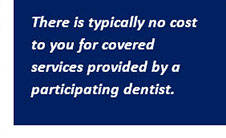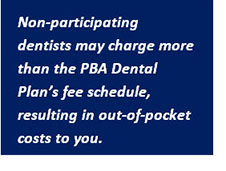



The PBA Health and Welfare Fund Dental Plan provides comprehensive dental benefits, usually at no cost to members, through a network of participating dentists. The Dental Plan covers the following categories of dental procedures:
Table 1: Coverage Summary |
|
|---|---|
| Category | Examples |
| Basic Diagnostic and Preventive Procedures | Routine Examinations, Cleanings, X-Rays |
| Restorative Procedures | Fillings |
| Endodontic Procedures | Root Canal |
| Prosthodontic Procedures | Crowns, Bridges, Dentures |
| Periodontic Procedures | Gingivectomy, Osseous Surgery |
| Orthodontia (Available until Age 23) | Full Banding, Space Maintainers |
| Oral Surgery | Extractions, Dental Implants (Flat-dollar reimbursement) |
| Other | Palliative (Emergency) Treatment |
 The PBA Health and Welfare Fund Dental Plan maintains a network of participating dental providers. There is typically no cost to you for covered services provided by a participating dentist. You may incur out-of-pocket expenses if you have exhausted plan benefit limits or if non-covered services are provided. You will not be required to complete claim forms when using a participating provider.
The PBA Health and Welfare Fund Dental Plan maintains a network of participating dental providers. There is typically no cost to you for covered services provided by a participating dentist. You may incur out-of-pocket expenses if you have exhausted plan benefit limits or if non-covered services are provided. You will not be required to complete claim forms when using a participating provider.
 Non-Participating Dental Providers
Non-Participating Dental ProvidersCovered services performed by non-participating dental providers are covered up to a maximum of the Dental Plan’s out-of-network reimbursement schedule. You may file a claim form with the PBA Funds Office for reimbursement for out-of-network services. Claim forms can be obtained by contacting the PBA Funds Office, or you can print claim forms from this website. An American Dental Association Claim Form will also be accepted. All claims must be filed within twelve (12) months of the date of service. It is important to note that if you use a non-participating dental provider, you will likely have out-of-pocket costs for charges exceeding the Dental Plan’s network fee schedule.
Some covered services and procedures are subject to dollar maximums and/or frequency limitations. Table 2, below, describes benefit limits for some of the most common covered services/procedures. For a full list of benefit limits and prior-authorization requirements, please contact the PBA Funds Office.
A number of dental procedures covered by the Dental Plan require prior-authorization. If a procedure is subject to prior-authorization, your dentist must obtain approval from the Plan before performing the procedure. In the event that more than one course of treatment is available, the Fund has the discretion to determine the procedure on which payment will be based. If you elect to proceed with an alternative course of treatment, you will be responsible for any cost in excess of the Plan’s payment for the procedure that the Fund authorized.
Table 2 below shows a summary of the benefit limits and prior-authorization requirements for the most common dental services covered by the PBA Health and Welfare Fund Dental Plan. For a full list of benefit limits and prior-authorization requirements, please contact the PBA Funds Office.
Table 2: Summary of Benefit Limits and Prior Authorization |
||
|---|---|---|
| Service/Procedure | Benefit Limit | Prior Authorization Required |
| Routine Examination | One exam every six (6) months. | No |
| X-Rays | Dollar maximum per 12-month period based on Plan fee schedule. | No |
| Dental Prophylaxis (Cleaning/Scaling/Root Planing) | Once every six (6) months. | No |
| Crowns, Bridges, Inlays, Onlays, and full or partial dentures | Can only be replaced once every five (5) years. | Yes |
| Orthodontia | Benefits are only available to dependent children until the age of 23. | Yes |
| Periodontics | Only covered when performed by a periodontic specialist.Dollar maximums and frequency limits apply based on type of procedure. | Yes |
| Fillings | Dollar maximum per 12-month period per tooth based on Plan fee schedule. | No |
| Dental Implants | One implant per arch, per twelve (12) month period. Benefits are limited to a flat-dollar reimbursement of $600.00. Reimbursement is only available for implants performed by a board certified oral or maxillofacial surgeon or periodontist. Implants can be replaced, if necessary, after 10 years. | Yes |
| A full list of benefit limits and prior authorization requirements can be found in the “Dental Plan Schedule of Allowances.” | ||
Whenever the PBA Health and Welfare Fund Dental Plan makes a payment to your dentist or to you, you will receive an Explanation of Benefits (EOB). The EOB is not a bill. The EOB describes the services that were performed and tells you how much the Plan paid. It is important to review your EOB for accuracy. If you receive an EOB for a service that was not performed, please contact the PBA Funds Office as soon as possible so that any discrepancies can be addressed.
The following tips will help you get the most out of your Dental Plan:
A fixed reimbursement for dental implants is available through the Dental Plan. The Plan will reimburse a flat dollar amount of $600.00 per implant, with a limit of one (1) implant per arch, per twelve (12) month period. Please note that the mouth consists of two (2) arches, an upper arch and a lower arch. Implant benefits are only available for implant procedures performed by a board certified oral or maxillofacial surgeon or periodonist.
To obtain reimbursement for dental implants:
Please be aware that dental implants may result in out-of-pocket costs, including:
 Coordination of Benefits
Coordination of BenefitsThe Health and Welfare Fund coordination of benefits (COB) provision applies to the Dental Plan. Please refer to Section I (Eligibility) of this Plan Description for details regarding COB. If you or one of your dependents uses other dental coverage that is primary to this plan, you may apply for secondary benefits by completing a paper claim form and submitting it directly to the PBA Funds Office. Claim forms can be obtained by contacting the PBA Funds Office, or you can print claim forms from claim forms from this website. An American Dental Association Claim Form will also be accepted. As a secondary payer, the Fund will: